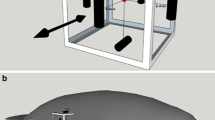Abstract
Terrestrial species that forage underwater face challenges because their body parts and senses are adapted for land — for example, it is widely held that mammals cannot use olfaction underwater because it is impossible for them to inspire air (sniff) to convey odorants to the olfactory epithelium1,2,3,4,5. Here I describe a mechanism for underwater sniffing used by the semi-aquatic star-nosed mole (Condylura cristata) and water shrew (Sorex palustris). While underwater, both species exhale air bubbles onto objects or scent trails and then re-inspire the bubbles to carry the smell back through the nose. This newly described behaviour provides a mechanism for mammalian olfaction underwater.



Similar content being viewed by others
References
Howell, A. B. Aquatic Mammals: Their Adaptations to Life in the Water (Thomas, Springfield, Illinois, 1930).
Stephan, H., Baron, G. & Fons, R. Z. Zool. Syst. Evol. 22, 328–342 (1984).
Estes, J. A. in Carnivore Behavior, Ecology, and Evolution vol. 1 (ed. Gittleman, J. L.) 242–282 (Cornell University Press, Ithaca, New York, 1989).
Sanchez-Villagra, M. R. & Asher, R. J. Mammalia 66, 93–109 (2002).
Repenning, C. A. Syst. Zool. 25, 375–390 (1976).
Catania, K. C. Brain. Behav. Evol. 56, 146–174 (2000).
Kepecs, A., Uchida, N. & Mainen, Z. F. Chem. Senses 31, 167–179 (2006).
Uchida, N., Kepecs, A. & Mainen, Z. F. Nature Rev. Neurosci. 7, 485–491 (2006).
Youngentob, S. L., Mozell, M. M., Sheehe, P. R. & Hornung, D. E. Physiol. Behav. 41, 59–69 (1987).
Author information
Authors and Affiliations
Ethics declarations
Competing interests
The author declares no competing financial interests.
Supplementary information
Supplementary Information
This file contains supplementary material.
Video 1
Video 1 shows wide angle, slow motion view of a star-nosed mole sniffing underwater.
Video 2
Video 2 shows star-nosed mole sniffing a piece of wax underwater - note that the bubble contacts the wax.
Video 3
Video 3 shows a star-nosed mole “sniffing” through a metal grid to control for touch with the star.
Video 4
Videos 4 and 5 were captured with a Cannon XL-1 video recorder and show a star-nosed mole during the scent tracking behavior.
Video 5
Videos 4 and 5 were captured with a Cannon XL-1 video recorder and show a star-nosed mole during the scent tracking behavior.
Video 6
Video 6 shows a water shrew sniffing various objects underwater in slow motion.
Video 7
Video 7 shows a water shrew during the scent tracking behavior.
Rights and permissions
About this article
Cite this article
Catania, K. Underwater 'sniffing' by semi-aquatic mammals. Nature 444, 1024–1025 (2006). https://doi.org/10.1038/4441024a
Received:
Accepted:
Published:
Issue Date:
DOI: https://doi.org/10.1038/4441024a
- Springer Nature Limited
This article is cited by
-
Sea Lions Develop Human-like Vernix Caseosa Delivering Branched Fats and Squalene to the GI Tract
Scientific Reports (2018)
-
The neurobiology and behavior of the American water shrew (Sorex palustris)
Journal of Comparative Physiology A (2013)
-
Sensory biology of aquatic mammals
Journal of Comparative Physiology A (2013)
-
Heterochrony and developmental modularity of cranial osteogenesis in lipotyphlan mammals
EvoDevo (2011)
-
Small Mammals Rule!
Journal of Mammalian Evolution (2011)





